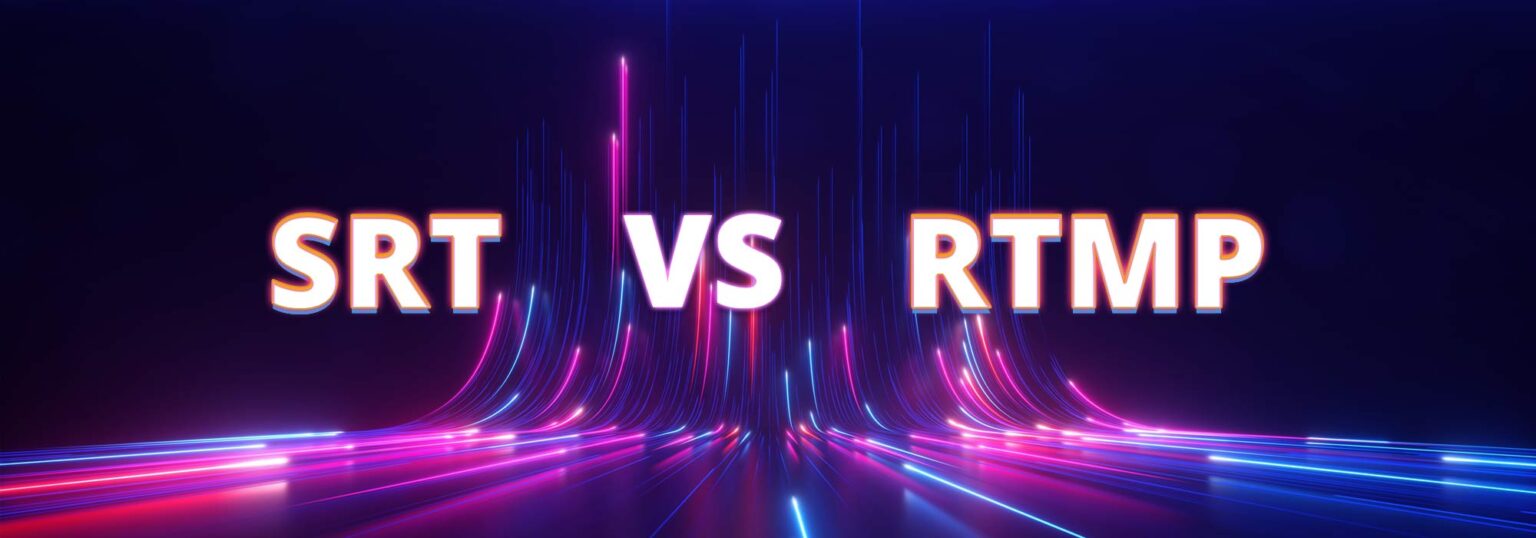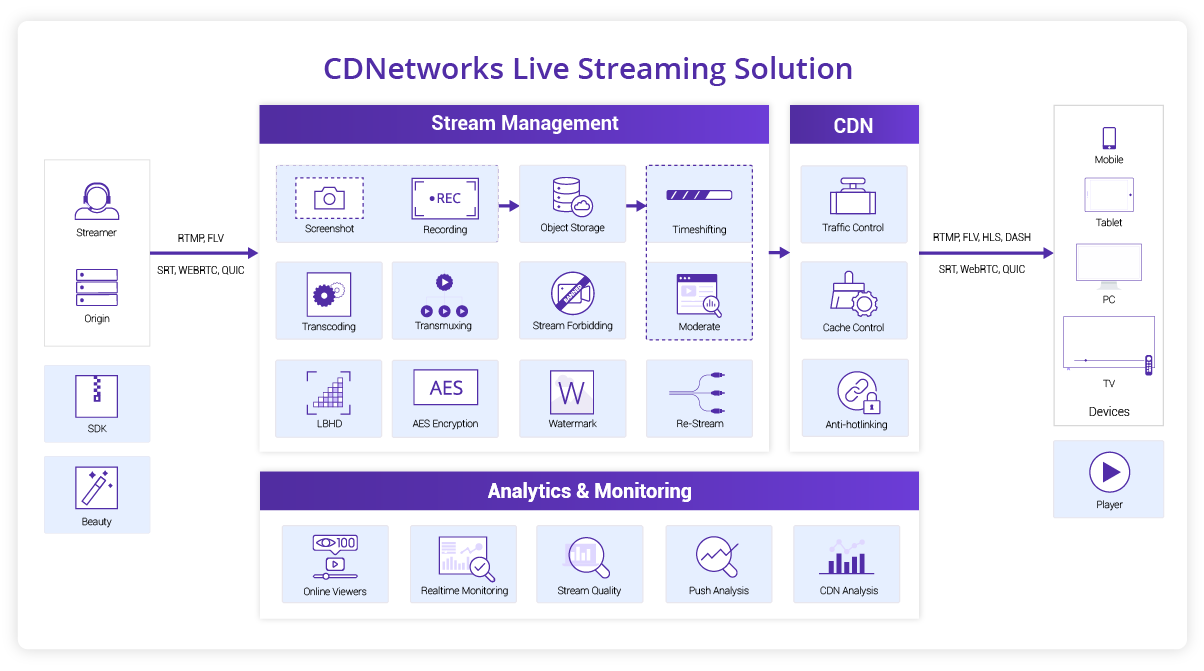Try CDNetworks
For Free
Most of our products have a 14 day free trial. No credit card needed.

Streaming has become the backbone of modern content delivery, transforming how businesses connect with audiences worldwide and deliver high-quality video content seamlessly. From video platforms serving billions of users to gaming companies pushing real-time updates to players globally, the streaming ecosystem continues to expand at an unprecedented rate. As audiences grow and demand more immersive experiences, businesses face increasing pressure to deliver high-quality content quickly and reliably across the globe. This rapid evolution of streaming technology and expanding user base presents exciting opportunities and significant challenges for content providers.
For online streaming alone, the global live streaming market was valued at USD 87.8 billion in 2024 and is expected to reach USD 605.2 billion by 2033, growing at a CAGR of 23.93%.
Key to the continued rise of these trends is the rapid adoption of various streaming protocols, including SRT (Secure Reliable Transport) and RTMP (Real-Time Messaging Protocol).
Streaming protocols are integral components of online multimedia experiences. They determine how data is transmitted from a media source to an end user’s device, enabling real-time playback without downloading the entire file. These protocols are designed to tackle the challenges of varying network conditions, ensuring a smooth and uninterrupted streaming experience.
Video streaming protocols, in particular, focus on delivering video content efficiently. They take into account factors like latency, quality, and reliability to provide a seamless viewing experience. These protocols are the backbone of streaming platforms, enabling you to watch high-definition videos in real-time, engage in live broadcasts, and even participate in video conferencing.
SRT is an open-source video transport protocol developed by Haivision and designed to connect two endpoints for delivering low-latency video and media streams across diverse networks, including the public internet, while supporting real-time interactivity. It was introduced in 2013 to enhance streaming performance over some types of networks. It has become an industry standard, especially for time-sensitive streaming use cases like live sports and breaking news.
SRT relies on an intelligent packet retransmit process called ARQ (Automatic Repeat reQuest) in addition to a UDP data flow, and with AES-128 and 256-bit encryption. Since becoming open source in 2017, SRT has gained rapid adoption.
The growth of SRT has been so significant that Haivision received an Emmy Award in 2018 for pioneering reliable streaming. It has also gained endorsements from major industry players such as Microsoft, Adobe, Wowza, and Vimeo.
RTMP was pioneered as Adobe’s protocol for streaming video content to Adobe Flash players and quickly became a standard for early online streaming platforms. Its TCP-based structure provides a steady flow of data with retransmission control, which helps minimize packet loss and maintain consistent quality across diverse network conditions.
Although Adobe Flash has been discontinued, RTMP remains widely supported by encoders, media servers, and CDN providers due to its simplicity and reliability. Many broadcasters continue to use RTMP to ingest live events before rewrapping streams into newer protocols such as HLS, DASH, or SRT, ensuring smooth, low-latency video delivery. This long-standing reliability and broad compatibility keep RTMP relevant for modern workflows where secure and stable transport over the public internet is essential.
The table below compares their strengths across key dimensions to help identify which protocol best fits different streaming environments.
| Dimension | SRT | RTMP |
|---|---|---|
| End-to-End Latency | 🚀 Very low (2x+ faster) | ⚡ Low |
| Video Quality & Bandwidth | ✅ Stable up to 20 Mbps | ❌ Fails at high bitrates |
| Security | 🔒 AES encryption | ❌ No built-in security |
| Reliability | ✅ Advanced error correction | ❌ Firewall sensitivity |
| Adaptive Streaming | ✅ Yes | ❌ No |
| Compatibility | ❌ Limited | ✅ Broad compatibility |
| Ease of Implementation | ❌ Complex | ✅ Simple |
| Cost | ✅ Both are cost-effective | |
Extensive real-world testing confirms that SRT and RTMP serve different priorities. SRT is built for low-latency, secure delivery even on unpredictable networks, while RTMP remains the simpler choice for platforms where broad compatibility is the priority. The following benchmarks show how these differences translate into measurable performance results.
Tests consistently show SRT’s clear advantage in latency. With optimized error correction and efficient packet recovery, SRT delivers streams more than twice as fast as RTMP. When hardware acceleration is involved, that margin widens significantly — SRT can achieve five to twelve times faster end-to-end performance under ideal conditions.
RTMP performs reasonably well when the sender and receiver are close geographically, but struggles with high bitrates and longer distances. Beyond 2 Mbps or across unstable networks, RTMP often falters, while SRT maintains stable throughput up to 20 Mbps, sustaining consistent video quality even over global connections.
Beyond raw performance metrics, each protocol offers distinct features and capabilities that impact its suitability for different streaming applications. Here’s a detailed analysis of their core strengths and limitations:
SRT prioritizes security and adaptive streaming, making it ideal for sensitive content. Its proven track record in security, reliability, and adaptability has established it as a leading protocol in the streaming community, especially for time-sensitive live events. Operating with UDP (User Datagram Protocol), SRT is specifically designed for real-time applications like video streaming.
While SRT offers superior performance, certain considerations exist. Implementation requires more technical expertise and resources compared to simpler protocols. Interoperability limitations mean it may not be supported by all streaming platforms. Network conditions can still impact performance despite its advanced optimization features.
RTMP remains a robust solution for low-latency communication, particularly suitable for live broadcasts and gaming. As a TCP-based protocol, it splits streams into smaller chunks of data for faster delivery.
Key limitations of RTMP include its lack of built-in security features, creating potential vulnerability to security threats. Additional challenges include limited multilingual support and ad insertion capabilities. Firewall interactions can cause connectivity issues, impacting performance.
Integration support for RTMP is diminishing as other protocols like HLS and MPEG-DASH gain preference among Content Delivery Networks (CDNs). Furthermore, its proprietary nature involves licensing fees and lacks community-driven development opportunities.
CDNetworks helps businesses with their live streaming needs through a number of solutions, while also being powered by our CDN capabilities.

These solutions include Media Delivery, such as Media Acceleration Live Broadcast, as well as Low Latency Streaming, both delivering real-time and seamless streaming experiences to global users.
Our solutions also support both SRT and RTMP protocols, which means you can take advantage of our capabilities, no matter your preference.
👉 Start your free trial today and experience seamless live streaming with CDNetworks.
On December 3, 2025 (EST), a critical security vulnerability was discovered in React Server Components, rated with a CVSS score of 10.0.
We continuously innovate to meet the evolving challenges of WAAP in today’s digital ecosystem. In this post, we’ll explore the key capabilities of the CDNetworks WAAP solution.